27 July, 2002
Due to the great depth (2000 meters) at this station,
we only did the Haps core sampling for the mud at the
bottom. The five van Veen grabs would take up too
much ďwire timeĒ (the time it takes to send the
equipment down and back). The multi-Haps core sampler
should pull up four cores at a time and, by sending it
down twice, Jackie will have more than enough samples.
However, it is not unusual to run into problems,
especially at these depths, both due to equipment and
changing drift conditions. Today we had to send the
corer down three times in order to get the samples we
needed. Thanks to Steve Roberts, the JOSS (Joint
Office of Science Support) data management person on
board, I have a record of the sampling process. Be
sure to check it out in the series of pictures below.
Keep in mind as you look at the pictures that Jackie
Grebmeierís interest is the benthic organisms. Itís
important to understand what lives at the bottom and
the characteristics of their environment (the
sediments) in order to see what part they play in the
overall scheme of carbon cycling. When the cores come
up, sub samples of the sediments from one of them are
taken for a variety of tests. A chlorophyll test
gives an indication of the phytoplankton present in
the sediment. Remember that phyto means plant and
phytoplankton contain chlorophyll, a green pigment
found in all plants. Another sample is collected for
HPLC analysis. This is high performance liquid
chromatography, a fancy name for a process that
separates out the phytoplankton by the pigments
(colors) they contain. Another sub sample yields TOC
(total organic carbon) and TON (total organic
nitrogen). The results can provide an indication of
the source of the organic material in the mud, a ratio
of marine (salt water) to terrestrial (terra = land)
organisms. Carbon-13, an isotope of carbon, will be
analyzed from the same sub-sample and will provide
similar information. Lastly, we preserve the samples
for analysis for a series of radio-isotopes such as
beryllium-7, lead- 210, cesium-137, plutonium, and
radium. These are called tracers because they tell us
what forms of carbon and how much arrives at the
sediment surface from overlying water column
processes.
Once all the cores are on deck and the sub-samples are
removed, Jackie chooses two cores for her 12-24 hour
respiration experiments. (Check out the journal
photos for July 22.) When she is finishes with
those, they are sieved to remove all mud and to
preserve the organisms left behind. We then take one
of the other cores collected to cut into sections to
be canned and brought back to the University of
Tennessee for further analysis. Thatís the time when
we get to come inside and actually work with the mud.
When itís not full of byssal threads from mussels in
the core, itís an easy job. We take off one
centimeter (a little less than Ĺ inch) slices at a
time for the first four sections. After that we
remove two centimeter slices until the core is
finished. Because we are near the end of the sampling
at each station, we are often working into the early
morning hours or even through the night. In case you
think that is difficult, check out the last picture to
see what our surroundings look like while we are on
deck!
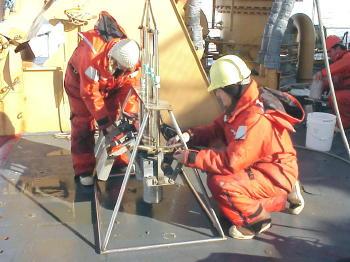
Jackie Grebmeier designed this multi-Haps core. The original design only takes one core at a time. This one takes four. Jackie is the one at the end with the white hat.
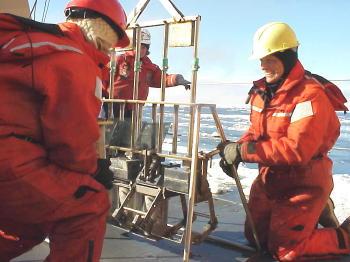
Everything must be checked before the Haps goes into the water. Once it reaches the bottom, the tension on the wire releases and the cores drop into the sediment.
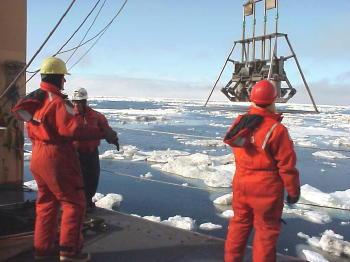
There is always an MST (marine science technician) on deck to direct whatever sampling operation is going on. He or she works with another MST who controls the operation of the winch. Together they make certain that the equipment is deployed correctly and safely.
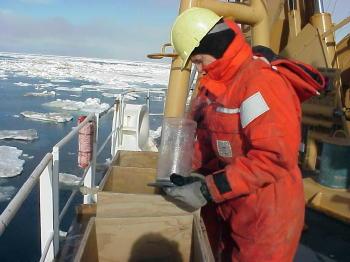
While we are waited for the Haps core to return to the surface I sieved the core from Jackie's respiration experiments. At this depth (2000 meters) there are very few organisms.
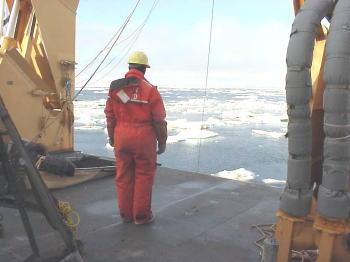
It takes at least one and a half hours for the Haps core to get to the bottom and back when it is this deep. Sometimes, when standing on the back of the ship, I am reminded that little separates me from water that is 2000 meters deep!
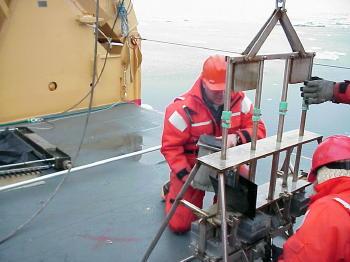
Lee Cooper, co-chief scientist on board, removes one of the core samples after the Haps comes back on deck. Some of the analysis is his work.
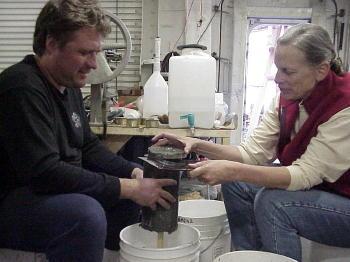
Once we select one core for sectioning, we start at the top with one centimeter slices. This looks like a two centimeter slice that Jim Bartlett (science technician for Lee Coper and Jackie Grebmeier)and I are getting from further down in the core.
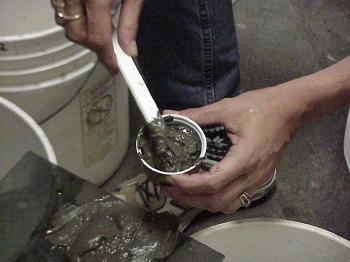
As we remove each layer of mud, we collect a sample into carefully labeled cans which will be taken back to the University of Tennessee where the mud will be analyzed.
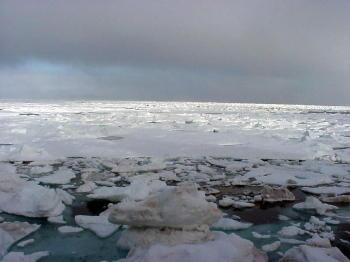
Working into the early morning hours has its advantages. Look at the view we get from the back deck!
Contact the TEA in the field at
.
If you cannot connect through your browser, copy the
TEA's e-mail address in the "To:" line of
your favorite e-mail package.
|
